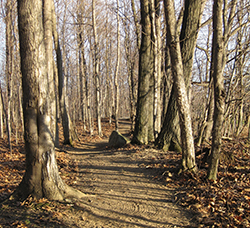Property Changes and Water Quality
 by Executive Director Chris Boget
by Executive Director Chris Boget
January is a time to plan ahead and make New Year’s resolutions. If one of your 2016 goals is to make changes to your property, make a resolution to keep water quality in mind during the planning phase. Smart project design and a little knowledge can go a long way toward protecting local waterways that eventually flow into Lake Champlain.
Before you design your new shed, garden, or path, take some time to consider how the improvement could impact the land and nearby waterways. When we make changes to our properties, we may impact water quality in some way—the key is to take steps to limit any sediment and pollutant runoff.
The first step is to inventory the natural features of your property. Are there streams or wetlands present? Do you have shoreline on Lake Champlain or another waterbody? Does your property contain steep slopes? Are there any culverts, ditches or drains near your property? The closer your property is to a stream, lake, or ditch, the more care and consideration will be needed in the design phase. Similarly, steeper areas—which erode faster than gentle slopes—require more attention.
From a water quality perspective, when it comes to adding a shed, gazebo, or fenced garden to your property, the old real estate adage applies; it’s about location, location, location. When possible, keep new structures out of vegetated areas that “buffer” adjacent waterbodies. Keeping forested buffers intact, and steep areas undisturbed, helps reduce erosion and maintain the land’s natural ability to absorb water.
Well-designed trails and paths can enhance your family’s enjoyment of your property. To plan a path with water quality in mind, location, design and construction materials matter. As with structures, make an effort to keep paths out of areas that buffer waterways and off steep slopes. Please consider limiting the extent of the area disturbed by creating paths that are only as wide as necessary. For sloping sections, incorporate carefully designed trail techniques that use the natural contours of the land to sweep stormwater off the trails before the water creates downhill gullies. For example, one technique is to create winding, back and forth S-curves to reduce the speed of water flowing downhill. Marking the trail with old logs, paint, or flags allows one to leave the natural layer of old leaves to help prevent the trail from eroding during storms.
Of course shoreline landowners will want to check on the newly passed State of Vermont regulations on any land use changes in shoreland areas. In any area in Vermont, when clearing a trail through a forested area, avoid removing large canopy trees. Mature trees not only keep soils in place and soak up stormwater, they also naturally shade out the small trees that would require more trail maintenance in the future. Instead of leveling the ground surface, keep the natural ups, downs, and bumps of the forest floor to help the ground soak up extra rainwater. Lastly, it is best to schedule tree removal—especially jobs involving heavy equipment like backhoes—for a time when the ground is frozen to minimize soil disturbance.
By considering water quality when planning changes to your property, you can help limit erosion, reduce future maintenance, and protect Lake Champlain. To learn more about how you can help improve water quality, please contact us at .

